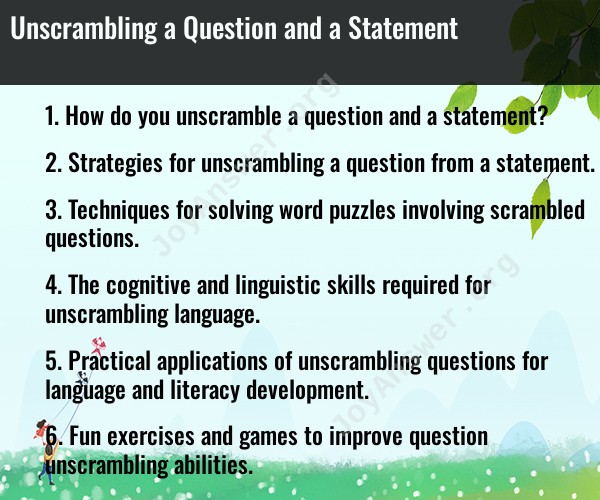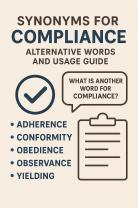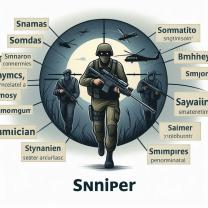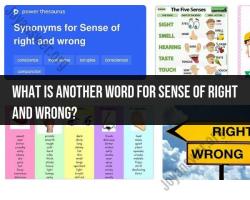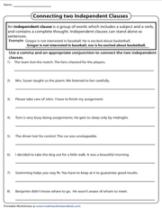How do you unscramble a question and a statement?
Unscrambling a question and a statement means rearranging the words or components of a sentence to make it coherent and grammatically correct. The specific method you use depends on the nature of the original sentence, but here are some general guidelines:
Unscrambling a Question:
- Identify the key elements: Determine the subject, verb, and any auxiliary words (e.g., "do," "can," "will") in the question.
- Rearrange the elements: Reorder the words to form a coherent sentence. Ensure that the subject and verb are in the right order.
- Adjust for tense and syntax: Ensure that the verb tense and word order are appropriate for the statement format.
Example:Original Question: "Did you go to the store?"Unscrambled Statement: "You went to the store."
Unscrambling a Statement:
- Identify the key elements: Determine the subject and verb in the statement.
- Rearrange the elements: Reorder the words to form a question. Typically, you'll need to add an appropriate question word (e.g., "what," "where," "how") at the beginning of the sentence to make it a question.
- Adjust for tense and syntax: Ensure that the verb tense and word order are appropriate for the question format.
Example:Original Statement: "She is reading a book."Unscrambled Question: "What is she reading?"
Keep in mind that unscrambling a sentence can sometimes be challenging, especially if the original sentence is complex or if it involves multiple clauses. Practice and a good understanding of grammar and syntax are valuable for unscrambling sentences effectively.
Strategies for unscrambling a question from a statement.
There are a few strategies that can be used to unscramble a question from a statement:
- Identify the key words in the statement. These are the words that are most likely to be found in the question.
- Look for patterns in the statement. For example, if the statement is in a question-and-answer format, the question may be hidden in the answer.
- Try to rephrase the statement as a question. This can help you to identify the missing words and the correct order of the words.
Techniques for solving word puzzles involving scrambled questions.
There are a few techniques that can be used to solve word puzzles involving scrambled questions:
- Start by looking for the longest words in the puzzle. Once you have found the longest words, you can start to build the other words around them.
- Try to identify the parts of speech of the words. This can help you to determine the order of the words in the question.
- Use the context of the puzzle to help you solve it. For example, if the puzzle is about animals, you can look for words that are related to animals.
The cognitive and linguistic skills required for unscrambling language.
Unscrambling language requires a number of cognitive and linguistic skills, including:
- Phonological awareness: This is the ability to hear and manipulate the sounds in words.
- Vocabulary knowledge: This is the knowledge of the meaning and use of words.
- Grammar knowledge: This is the knowledge of the rules of language, such as syntax and morphology.
- Problem-solving skills: This is the ability to identify and solve problems.
Practical applications of unscrambling questions for language and literacy development.
Unscrambling questions can be used to develop a number of language and literacy skills, including:
- Vocabulary development: Unscrambling questions can help children to learn new words and to understand the meaning of words in context.
- Grammar development: Unscrambling questions can help children to learn the rules of language and to use grammar correctly.
- Reading comprehension: Unscrambling questions can help children to develop their reading comprehension skills by requiring them to think critically about the text.
- Critical thinking skills: Unscrambling questions can help children to develop their critical thinking skills by requiring them to identify and solve problems.
Fun exercises and games to improve question unscrambling abilities.
There are a number of fun exercises and games that can be used to improve question unscrambling abilities, including:
- Scrambled question puzzles: These puzzles involve unscrambling words to form questions.
- Word search puzzles: These puzzles involve finding words in a grid of letters. Some word search puzzles may include scrambled questions.
- Crossword puzzles: These puzzles involve filling in a grid of squares with words that fit the clues. Some crossword puzzles may include scrambled questions as clues.
- Question and answer games: These games involve answering questions about a specific topic. Some question and answer games may involve unscrambling questions.
Overall, unscrambling questions can be a fun and challenging activity that can help to develop a number of language and literacy skills.
